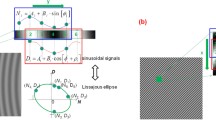Abstract
The systematic tendency of PIV evaluations to bias towards integral pixel values is known as peak-locking. These errors, although small, significantly affect the statistics extracted from such measurements. In this paper, the process by which such errors accrue is modeled, and a scheme for the removal of the same is suggested. Specifically, the modeling process considers FFT PIV with discrete window offset. The results are applied to actual situations and the results are found to be encouraging. The process is computationally inexpensive, and can be applied as a post processing technique to existing data to correct peak-locking.








Similar content being viewed by others
References
Adrian RJ (1991) Particle-imaging techniques for experimental fluid mechanics. Ann Rev Fluid Mech 23:261–304
Angele KP, Muhammad-Klingmann B (2005) A simple model for the effect of peak-locking on the accuracy of boundary layer turbulent statistics in digital piv. Exp Fluids 38:341–347
Chen J, Katz J (2005) Elimination of peak-locking error in piv analysis using the correlation mapping method. Meas Sci Technol 16:1605–1618
Cholemari MR (2004) Buoyancy driven turbulence in a vertical pipe. Ph.D. Thesis, Department of mechanical engineering, Indian Institute of Science
Cholemari MR, Arakeri JH (2005) Experiments and a model of turbulent exchange flow in a vertical pipe. Int J Heat Mass Transfer 48:4467–4473
Christensen KT (2004) On the influence of peaklocking errors on turbulence statistics compared from piv ensembles. Exp Fluids 36(3):484–497
Gui L, Wereley S (2002) A correlation-based continuous window-shift technique to reduce the peak-locking effect in digital piv image evaluation. Exp Fluids 32:506–517
Huang H, Dabiri D, Gharib M (1997) On the errors of digital particle image velocimetry. Meas Sci Technol 8:1427–1440
Keane RD, Adrian RJ (1992) Theory of cross-correlation analysis of piv images. Appl Sci Res 49:191–215
Lecordier B, Demare D, Vervisch LMJ, Réveillon J, Trinité M (2001) Estimation of the accuracy of piv treatments for turbulent flow studies by direct numerical simulation of multi-phase flow. Meas Sci Technol 12(1382–1391)
Liao Q, Cowen EA (2005) An efficient anti-aliasing spectral continuous window shifting technique for piv. Exp Fluids 38:197–208
Nogueira J, Lecuona A, Rodriguez PA (2001) Identification of a new source of peak locking and its removal in conventional and super-resolution piv techniques. Exp Fluids 30:309–316
Piirto M, Eloranta H, Saarenrinne P, Karvinen R (2005) A comparative study of five different piv interrogation algorithms. Exp Fluids 39:571–588
Pope SB (2000) Turbulent flows. Cambridge University Press, Cambridge
Prasad AK (2000) Particle image velocimetry. Curr Sci 79:51–60
Prasad AK, Adrian RJ, Landreth CC, Offutt PW (1992) Effect of resolution on the speed and accuracy of particle image velocimetry interrogation. Exp Fluids 13:105–116
Raffel M, Willert CE, Kompenhans J (1998) Particle image velocimetry. Springer, Heidelberg
Roesgen T (2003) Optimal subpixel interpolation in particle image velocimetry. Exp Fluids 35:252–256
Roth GI, Katz J (2001) Five techniques for increasing the speed and accuracy of piv interrogation. Meas Sci Technol 12:238–245
Saddoughi SG, Veeravalli SV (1994) Local isotropy in turbulent boundary layers at high reynolds number. J Fluid Mech 268:333–372
Scarano F, Reithmuller ML (2000) Advances in iterative multigrid piv image processing. Exp Fluids [suppl], pp S51–S60
Westerweel J (1997) Fundamentals of digital particle image velocimetry. Meas Sci Tech 8:1379–1392
Westerweel J (2000a) Effect of sensor geometry on the performance of piv interrogation. In: Adrian RJ, Durao DFG, Durst F, Heitor MV, Maeda M, Whitelaw JH (eds) Laser techniques applied to fluid mechanics. Springer, Heidelberg, pp 37–55
Westerweel J (2000b) Theoretical analysis of the measurement precision in particle image velocimetry. Exp Fluids [suppl], pp s3–s12
Westerweel J, Dabiri D, Gharib M (1997) The effect of a descrete window offset on the accuracy of cross-correlation analysis of digital PIV recordings. Exp Fluids 23:20–28
Acknowledgments
The author gratefully acknowledges Prof. Ajay K. Prasad and Dr. K. R. Sreenivas for discussions on PIV and Prof. Jaywant H. Arakeri for technical discussions. Financial support from Naval Research Board through scheme NRB006 is acknowledged.
Author information
Authors and Affiliations
Corresponding author
Rights and permissions
About this article
Cite this article
Cholemari, M.R. Modeling and correction of peak-locking in digital PIV. Exp Fluids 42, 913–922 (2007). https://doi.org/10.1007/s00348-007-0300-8
Received:
Revised:
Accepted:
Published:
Issue Date:
DOI: https://doi.org/10.1007/s00348-007-0300-8




